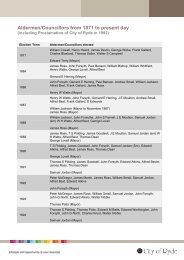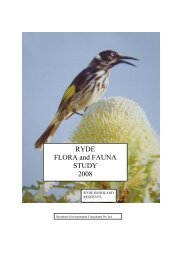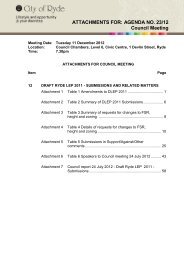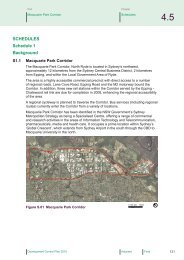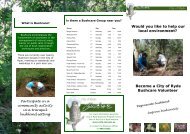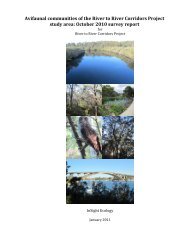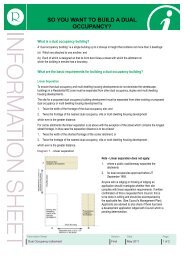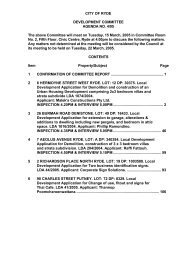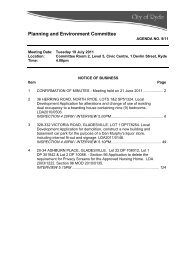RYDE FLORA and FAUNA STUDY 2007 - City of Ryde - NSW ...
RYDE FLORA and FAUNA STUDY 2007 - City of Ryde - NSW ...
RYDE FLORA and FAUNA STUDY 2007 - City of Ryde - NSW ...
You also want an ePaper? Increase the reach of your titles
YUMPU automatically turns print PDFs into web optimized ePapers that Google loves.
1.2.1 <strong>Ryde</strong> Flora<br />
Biosphere Environmental Consultants Pty Ltd<br />
<strong>Ryde</strong> Flora <strong>and</strong> Fauna Survey <strong>2007</strong> 4<br />
Plant lists (including weed species) were prepared for each reserve or cluster <strong>of</strong><br />
reserves. Criterion-based testing was again used at each site to determine the correct<br />
identification <strong>of</strong> the vegetation communities in specific reserves. In some cases,<br />
vegetation communities not previously recognised were supported, <strong>and</strong> previously<br />
proposed vegetation communities failed the tests (usually because there were<br />
insufficient diagnostic species present). Blue Gum High Forest had been suggested for<br />
reserves along Terrys Creek <strong>and</strong> Burrows Park, but these classifications were not<br />
supported by the vegetation assessments carried out. Turpentine-Ironbark Forest was<br />
recognised in Pidding Park <strong>and</strong> Burrows Park. Western S<strong>and</strong>stone Gully Forest was<br />
recognised to be present in Field <strong>of</strong> Mars Reserve, Pidding Park, Pembroke Park <strong>and</strong><br />
Portius Park.<br />
Many <strong>of</strong> the reserves suffered from the encroachment <strong>of</strong> a large numbers <strong>of</strong> exotic or<br />
non-native plants in them <strong>and</strong> several recommendations are proposed to help retain<br />
the vegetative features <strong>of</strong> each reserve.<br />
Several rare plants were found, <strong>and</strong> the following three threatened species: Epacris<br />
purpurescens var purpurescens, Pimelea curviflora ssp curviflora in the Field <strong>of</strong> Mars<br />
Reserve, <strong>and</strong> Melaleuca deanei in Somerset Park.<br />
1.2.2 <strong>Ryde</strong> Fauna<br />
As was the case in the 2006 Flora <strong>and</strong> Fauna Study, particular animal groups that<br />
originally inhabited parts <strong>of</strong> the <strong>Ryde</strong> LGA have fared badly in the wake <strong>of</strong><br />
urbanisation, others have survived relatively unscathed. The groups most seriously<br />
affected by urban development in the <strong>Ryde</strong> Local Government Area are:<br />
* terrestrial mammals<br />
* large reptiles<br />
* frogs<br />
Terrestrial native mammals (such as dasyures, native rodents, b<strong>and</strong>icoots <strong>and</strong><br />
wombats) have almost completely disappeared from the area. No native terrestrial<br />
mammals were found in the reserves surveyed in the <strong>2007</strong> Flora <strong>and</strong> Fauna Study;<br />
thus, the only remaining native terrestrial mammals are those still surviving in the<br />
Field <strong>of</strong> Mars Reserve. It is possible that follow-up surveys may detect native<br />
mammals.<br />
The main reason for the widespread loss <strong>of</strong> terrestrial mammals appears to be through<br />
predation by exotic animals, such as foxes, cats <strong>and</strong> dogs. L<strong>and</strong> clearing, particularly<br />
<strong>of</strong> native undergrowth has left the ground-dwelling mammals highly vulnerable to<br />
attack by introduced predators (Banks, 2004).<br />
Large reptiles have been extensively eliminated. This includes goannas, large snakes,<br />
dragons (such as Bearded Dragons) <strong>and</strong> large skinks (such as Blue-tongue lizards).<br />
Many <strong>of</strong> these reptiles appear to have either been deliberately killed (mainly snakes),<br />
accidentally killed, or killed by domestic animals (White <strong>and</strong> Burgin, 2004).




